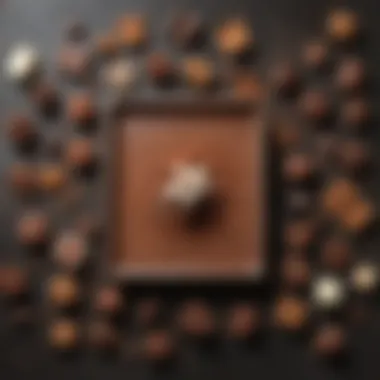Ultimate Guide to Making Delicious Hot Cocoa at Home


Intro
Hot cocoa is more than just a drink; it often signifies comfort and nostalgia. This guide aims to illuminate the multifaceted process of creating an exceptional cup of hot cocoa. With various methods and choices of ingredients, we explore different approaches to concocting this rich beverage to suit a range of tastes and preferences. Through a series of recipes, tips, and time-saving strategies, this article will provide insight on how to enjoy hot cocoa in its many forms, allowing everyone to craft their ideal cup.
Recipe Highlight
Classic Warm Cocoa
The classic warm cocoa stands out as a comforting drink that can satisfy taste buds on a chilly day.
Essential Ingredients:
- Milk or alternative (almond, oat)
- Unsweetened cocoa powder
- Sugar or honey to taste
- A pinch of salt
- Optional toppings (whipped cream, chocolate shavings, or marshmallows).
Estimated Preparation Time: 10 minutes
Servings: 2 cups
Step-by-Step Instructions
Making hot cocoa is simple. Follow these precise steps:
- Heat the Milk:
Place one cup of milk in a small saucepan over medium heat. Do not bring it to a boil; warm it until steaming. - Mix Cocoa and Sugar:
In a small bowl, combine 2 tablespoons of cocoa powder and 1 to 2 tablespoons of sugar, adjusting for sweetness preference. Add a small pinch of salt. - Blend with Cold Milk:
To create a smooth blend, whisk the cocoa mixture with two tablespoons of cold milk to form a paste. Recklessly mixing can cause lumps. - Combine and Heat Again:
Gradually add the cocoa paste to the warm milk, stirring constantly to ensure even distribution. - Finishing Touches:
Serve in a cup and enhance with your preferred toppings or spices.
Insider Tips:
Avoid boiling the milk as it may affect flavor and texture. A simple whisk is often sufficient for calming down any clumps.
Variations and Substitutions
Customization is key when creating hot cocoa. Here are some substitutions or alternative ingredients:
- Replace cocoa powder with dark chocolate for a richer taste.
- For a vegan option, utilize almond or coconut milk instead of dairy.
- For a minty flavor, candy canes or peppermint extract can elevate the drink.
Additionally, consider pairing hot cocoa with cookies or brownies for a delightful treat.
Time-Saving Cooking Tips
Maximizing efficiency while preparing can lead to a smoother experience. Some ways to enhance productivity while making hot cocoa include:
- Pre-measuring dry ingredients and storing them together can save time.
- Utilize an electric kettle to boil water quickly if making a powdered cocoa mix.
- Oddly, preparing larger batches can ease weekday stress. Store leftovers in the fridge and reheat when needed.
Useful Tools:
An immersion blender can froth the milk quickly, adding texture to your cocoa.
Nutritional Information
In a standard cup of hot cocoa made from whole milk and sugar, here are the calorie estimates:
- Calories per serving: approximately 200 calories.
- Key Nutrients: includes calcium, iron, and magnesium.
- For nutritional inclusivity, consider low-sugar or plant-based alternatives to cater to different dietary preferences.
Health Benefits
Cocoa contains antioxidants, contributing to improved heart health and reduced inflammation when enjoyed in moderation.
In summary, whether looking for a quick warmth or an elaborated treat, understanding how to make hot cocoa empowers personal enjoyment of this classic drink. By customizing key aspeccts and applying practical strategies, creating an ideal cup is just a few steps away.
Prelude to Hot Cocoa
Hot cocoa is not merely a beverage; it's a comforting experience steeped in tradition and culture. Understanding the intricacies of hot cocoa can enhance both preparation and enjoyment. This guide is structured to provide insights about there different components that build the perfect cup of hot cocoa.
Historical Context
Cocoa has a rich and varied history, begining with its origins in Mesoamerica. Ancient cultures like the Aztecs and Maya utilized cacao beans for ceremonial purposes and as a form of currency. Initially, the drink was bitter and often flavored with spices and chili. Over the centuries, lighting cocoa evolved as it spread globally. It merged with milk and sugar, leading to the sweetened varieties we now associate with hot cocoa today. The introduction of chocolate into desserts flourished during the 19th century. It also affected the way society perceived hot cocoa, turning it into a family-friendly treat.
Cultural Variations
Cocoa isn't limited to one style or flavor. Various cultures have distinct interpretations of hot cocoa, blending local ingredients and traditions. For example, in Mexico, hot chocolate is often served with a kick of cinnamon and sometimes even chili powder. In contrast, French hot chocolate leans towards a thicker, richer version, often served alongside pastries. Each variation expresses not only a unique taste but also reflects social customs tied to the individual cultures. Appreciating these differences enhances one's experience and understanding of hot cocoa in its many forms.
Essential Ingredients
The essence of making extraordinary hot cocoa lies significantly within its essential ingredients. Choosing the right components not only affects the taste but also determines the quality of the beverage you will create. Understanding these elements can help you enhance your hot cocoa’s richness, texture, and overall appeal. Throughout this section, we will break down the key ingredients, emphasizing their unique contributions and considerations.
Cocoa Powder
Cocoa powder serves as the backbone of any hot cocoa recipe. Its intense flavor adds depth and character that defines the drink. Knowing the types of cocoa powder available and their respective qualities is crucial for crafting an exceptional cup of hot cocoa.
Types of Cocoa Powder


Different types of cocoa powder exist, mainly categorized as natural and Dutch-processed. Natural cocoa powder has a light color and a stronger acidic flavor profile. The most distinct feature of this type is its high acidity, contributing to a deeper cocoa flavor.
On the other hand, Dutch-processed cocoa powder undergoes an alkalization process which reduces its acidity. This results in a smoother flavor and darker color. Many consider it as the popular choice among chocolate lovers for its rich color and mellower taste, making it ideal for hot cocoa. Noticing how these types can lead to different beverage profiles is essential—opt for natural for a sharper taste, and for the indulgent palate, try Dutch-processed.
Quality Considerations
Further along, focusing on quality is essential. High-quality cocoa powder means using product with lower additives and preservatives. One of its discernable features is a limited presence of artificial flavors. Choosing top-quality cocoa powder amplifies the richness and pureness of your drink. Be mindful to check labels for 100% cocoa to ensure you draw out the best flavor in your hot cocoa.
Before settling on a type, consider practical factors like price and availability, but note that a superior cocoa powder is likely to elevate the overall experience.
Milk Options
Milk is another primary ingredient that profoundly impacts the final product. It introduces creaminess, warmth, and depth to hot cocoa. Assessing the type of milk to use can affect both flavor and texture.
Dairy vs.
Non-Dairy
In choosing between dairy and non-dairy milk, consider dietary needs and flavor preferences. Dairy milk is the traditional option. Whole milk will create creamy hot cocoa, propelling the body's richness even further. Alternatively, non-dairy options include almond, soy, or oat milk. These alternatives offer unique flavors and varying textures.
Non-dairy milk can provide a lighter consistency or different nutritional benefits, making them favorable for lactose-intolerant individuals. Scenario analysis dictates whether the persona left for dairy or went an innovative route with non-dairy ingredients.
Fat Content
When catering to your target taste preferences, understanding fat content can provide clarity. Whole milk yields the richest flavor due to its higher fat. Additionally, reduced-fat milk offers a lighter alternative, making the beverage more suitable for certain diets. Fat content also affects the creaminess level, which plays a key role in the drink’s appeal.
Knowing how fat contributes to mouthfeel and richness should guide your choice in milk. Opting for whole or heavy cream can yield a lavishly textured hot cocoa, while skim milk suits those preferring a more moderate indulgence.
Sweeteners
Sweeteners provide balance to the inherent bitterness of cocoa powder. The choice of sweetener can redefine your hot cocoa experience.
Granulated Sugar
Granulated sugar remains one of the most common sweeteners used in hot cocoa preparation. Its key characteristic is its ability to dissolve seamlessly into warm liquids, ensuring a uniform flavor experience. One benefit of using granulated sugar is to mitigate the bitterness of natural cocoa, leading to a sweeter cup.
Examine package contents, too; often, pure cane sugar will offer a more superior taste compared to more processed varieties.
Alternative Sweeteners
With a move toward healthier eating, alternative sweeteners have gained popularity. Options like honey, agave nectar, erythritol, and stevia each offer a gamete of flavors while also being lower in calories. Alternative sweeteners often have distinctive characteristics; for example, honey provides a unique flavor profile while remaining minimal in calories. Thus, wise choose can both enhance taste and suitability for special dietary needs.
Like trajectory sourcing, careful selection can break free from refined sugars, concentrating varieties merging aim for essentials with intentional nuances.
Flavor Enhancements
Adding flavor enhancements transforms your hot cocoa effectively, helping personalize each cup to satisfy various entailments. Adjusting the flavor profile can tilt at favorite elements.
Vanilla Extract
Vanilla extract brings a natural sweetness and warmth to hot cocoa, integrating extraordinarily smoothly. A characteristic feature is that it meets linkage of sweet and creamy components; only a small amount is usually needed for significant flavor enhancement. Comparing value indicators throughout encourages embracing this ubiquitous yet elegant addition layered into hot beverages.
Remember, natural vanilla extract supersedes artificial variety, offering under-right flavor complexity while allowing a keen eye for organic ingredients that echo quality.
Spices and Herbs
Exploring the realm of spices and herbs like cinnamon or nutmeg can add an exciting kick to your cocoa. Their distinct characteristics supplement warmth while also conveying health benefits. Utilizing these spices unlocks warmth, tone or complexity varying from simple-to-rich and smooth harmonies appealing to eclectic cohorts. With light or adjustment, redefining comfort towards restorative lifting should enrich each moment deciding between choice and intention.
When considering additions during cocoa crafting, spotlight those possessing both flavor-enhancing and health-stimulating qualities, increasingly accommodating various audience presences effectively throughout its nurturing.
Basic Recipe for Hot Cocoa
The basic recipe for hot cocoa serves as the foundation for crafting this beloved beverage. Its importance lies not just in the final product but in the process and choices involved in its creation. A well-executed, basic recipe can elevate your cocoa experience while also allowing customization and personalization according to taste preferences. Furthermore, mastering this base can inspire creativity in exploring various flavors and additions in your cocoa journey.
Step-by-Step Instructions
To create the perfect cup of hot cocoa, adhere to these simple step-by-step instructions:
- Use Quality Ingredients: Start with quality cocoa powder. Dutch-processed cocoa provides a rich texture, while natural cocoa powder offers a stronger chocolate flavor.
- Select Your Milk: Decide between dairy and non-dairy options. Whole milk creates a creamier cocoa, while almond or oat milk can add unique flavors.
- Add Sweeteners and Flavorings: Stir in granulated sugar or an alternative sweetener until dissolved. Add a splash of vanilla extract or sprinkles of cinnamon to elevate the flavor.
- Heat Your Mixture: In a saucepan, mix your ingredients—2 tablespoons of cocoa powder, 2 tablespoons of sugar, and a pinch of salt in a small amount of your chosen milk. Gradually increase the heat, adding the remaining milk, continuously stirring to avoid any lumps.
- Simmer: Bring the mixture to a gentle simmer. This should take about 5 minutes. Ensure not to boil, as this can change the texture of the cocoa.
- Serve Hot: Once ready, pour the cocoa into a favorite cup or mug. If desired, top with warm whipped cream or a sprinkle of chocolate shavings for added flair.
Serving Suggestions
When it comes to serving hot cocoa, presentation matters just as much as taste. Here are a few suggestions to enhance your cocoa experience:


- Add Garnishes:
- Use the Right Cup: Choose a cup that holds heat well. A ceramic mug retains warmth longer than other materials. The size should also accommodate your serving. A good serving size hovers around 8 to 12 ounces, allowing plenty of space for toppings.
- A dollop of whipped cream adds a light creamy finish that complements the smooth cocoa.
- Marshmallows provide a contrast in texture and an additional delight for sweet-toothed fans.
- Chocolate shavings can add an elegant touch, making the cocoa visually appealing.
Experiment with different combinations and presentations. Hot cocoa can be both a comfort drink and a special treat when made with care and creativity.
Incorporating these elements into your hot cocoa not only enhances the overall drinking experience, but also provides the chance to explore various flavor profiles and textures. The journey of mastering the basic recipe opens up new avenues for experimentation and individual preferences.
Advanced Hot Cocoa Techniques
Hot cocoa is an exquisite indulgence that can be enhanced with various techniques. The aim of mastering these advanced hot cocoa techniques is to elevate the drinking experience from a simple cup of warm chocolate to a rich, flavorful beverage. These techniques incorporate blending methods as well as creative options to create hot cocoa mixes. Each technique presents unique characteristics that are beneficial for robust flavor and easy preparation.
Blending Methods
Using a Whisk
Using a whisk plays a vital role in making a smooth and well-integrated hot cocoa. This method allows for the cocoa powder and liquids to blend thoroughly without lumps, creating a consistent texture. A whisk is lightweight and simple to use, making it a go-to instrument when crafting hot cocoa. Although the manual effort may be more than using a blender, it provides greater control over how well everything is mixed, thus achieving a better taste profile.
One significant advantage of using a whisk lies in its ability to incorporate air into the mixture. This aeration creates a light and fluffy texture, making the cocoa feel luxurious and pleasing. However, achieving the ideal consistency can demand patience and arm strength, especially for larger batches.
Blender Techniques
Blender techniques offer a quick solution for those who prefer efficiency. A blender easily breaks up all cocoa solids, sugars, and liquids, producing a velvety hot cocoa. It is particularly advantageous for those who wish to combine hot cocoa with additional ingredients like whipped cream or flavored syrups quickly.
The main characteristic here is speed. In just a minute, you could have a hot cocoa perfectly mixed at the desired temperature. On the downside, relying on a blender may add extra cleaning afterwards, which some might find inconvenient compared to simply rinsing a whisk. It’s also important to ensure the blender is not overloaded to avoid spillage in the mixing process.
Creating Hot Cocoa Mix
Creating hot cocoa mixes is another advanced technique that offers both convenience and customization. These mixes can provide a consistent flavor and a quicker method to prepare this delightful drink.
Pre-made Mixes
Pre-made mixes are a popular choice for those seeking convenience without sacrificing flavor. These commercially available mixes aim to deliver that rich and comforting hot cocoa experience. One significant benefit includes time-saving, allowing just hot water or milk to transform a mix into a comforting beverage.
However, the unique feature lies in the ingredients that vary from brand to brand. Some might feature less quality cocoa, which can often result in a sweet but bland drink. Thus, read the labels: checking cocoa content can be wise for those very particular about flavors.
Homemade Mix Recipes
On the other hand, homemade mix recipes allow one to curate personal taste preferences easily. This choice conveys the joy of tailoring flavors tailored to individual likes, such as adjusting sweetness or incorporating different spices.
The essence of homemade mixes is that they enable control over ingredients. Ensuring quality cocoa, measured sugar, and selected additives means each blend can be refined for those who appreciate achieving specific preferences. However, creating these mixes requires upfront preparation but yields greater satisfaction in flavor. Proper storage is also essential to maintain freshness and aroma.
Each technique discussed contributes significantly to creating exceptional hot cocoa. Proper blending methods and choosing the right mix either commercial or homemade, open a spectrum of enjoyment with each warm cup. Understanding and mastering these facets ensures preparing hot cocoa is not just a task, but a delightful process.
Variations of Hot Cocoa
Exploring variations of hot cocoa allows this beloved beverage to transcend its traditional roots. Variations can enhance flavor, introduce new ingredients, and cater to diverse tastes and occasions. By experimenting with different factors, anyone can transform basic hot cocoa into a unique experience that reflects personal preferences.
Spiced Hot Cocoa
Spiced hot cocoa introduces warmth and comfort through spices. Adding cayenne pepper, cinnamon, or nutmeg can elevate the standard recipe significantly. These spices not only enhance the cocoa's rich taste but also provide health benefits.
- Cayenne pepper offers a kick, stimulating circulation and metabolism.
- Cinnamon adds sweetness and provides antioxidant properties.
- Nutmeg can contribute to relaxation, aiding in better sleep.
To create your own spiced hot cocoa:
- Start with a base of hot cocoa made from your chosen ingredients.
- Gradually mix in your spice of choice according to taste.
- Allow the drink to steep for a few minutes so the flavors meld together.
Consider trying to pair with a pinch of sea salt to further accentuate the rich chocolate flavor.
Mint-Infused Cocoa
Mint-infused cocoa provides a refreshing twist that is especially popular during winter months or holiday gatherings. Spearmint or peppermint extracts can be incorporated into the drink for enhanced flavor. The coolness of mint adds a contrast that complements the hot cocoa base.
When preparing mint-infused cocoa:
- Use whole mint leaves or extract.
- If using leaves, heat them in milk before straining them out right before serving for a deeper flavor.
The result is a beverage that feels festive and inviting, perfect for social occasions.
Mexican Hot Chocolate
Mexican hot chocolate differs notably from standard recipes. Its unique inclusion of ingredients such as cinnamon and dark chocolate creates a rich and less sweet flavor profile. This variation is common in Mexican cuisine and embraces the taste of semi-sweet chocolate alongside spices which enhance its complexity.


Typically, the method involves:
- Melting good-quality dark chocolate into milk on a low heat.
- Stirring in cinnamon and sometimes a pinch of cayenne for an interesting heat.
The character it brings is captivating. Like classic hot cocoa, it has a velvety mouthfeel but offers a different kind of indulgence that reveals itself with every sip.
The beauty of hot cocoa is in its endless adaptability. Thus, embodying influences and tastes from diverse cultures makes every cup exceptional.
Serving and Presentation
Serving hot cocoa goes beyond simply pouring the beverage into a cup. The presentation can significantly impact the overall experience. A well-served hot cocoa not only looks inviting but also enhances the flavors and enjoyment of the drink. When thoughtfully considered, the elements of serving create a tactile and visual satisfaction that completes the hot cocoa journey.
Garnishing Options
Whipped Cream
Whipped cream acts as a luxurious topping for hot cocoa. Its creamy texture balances the rich flavors of cocoa, making each sip more satisfying. It is popular because it adds a level of indulgence that warms the heart.
A unique feature of whipped cream is its ability to stabilize the temperature for longer. This keeps the cocoa warm under the luscious layer atop. However, it can be too sweet for some preferences, reducing the chocolatey flavor. Therefore, moderation helps to maintain a balanced taste in a well-crafted hot cocoa.
Chocolate Shavings
Chocolate shavings offer a sophisticated touch to hot cocoa presentations. They add an innovative twist, increasing the cocoa flavor. Furthermore, they lend it a visual elegance that helps create anticipation.
The main characteristic is the liberating flexibility of the shavings. One can choose different types, like dark, milk, or even white chocolate. However, due to being made of chocolate, this option can intensify the sweetness, which may not appeal to everyone. Finding the right balance is essential in creating the perfect mug.
Marshmallows
Marshmallows bring a friendly and nostalgic aspect to hot cocoa. They melt into the surface of the drink, introducing an additional layer of creaminess. Their fluffy consistency plays wonderful tricks on the palate, heightening the enjoyable aspects of hot cocoa.
The key appeal lies in their charm and playful experience when consumed. The downsides, however, include sometimes overwhelming sweetness and potential to mask delicate flavors in high-quality hot cocoa. Having a careful approach allows for delightful souvenirs from childhood while maintaining flavor integrity.
Cup Selection
Material Types
Material selection in cups can enhance the experience of hot cocoa. Options could range from ceramic to glass, each serving different functions. In general, ceramic tends to maintain heat better, making the drink enjoyable longer. Metal and glass, while aesthetically pleasing, can lose warmth quickly, affecting the experience.
One of the unique details is the varied insulation properties. Some materials keep a pleasant touch on the outside while others can get very hot. Choosing wisely optimizes the comfort a hot cocoa drinker experiences.
Size Considerations
Size plays a critical role in how a person enjoys hot cocoa. A larger cup may offer room for generous toppings, enhancing presentation potential. Smaller cups require balance, gifting a sense of moderation in enjoyment. Choosing appropriate size adds to the moment, allowing individuals to tailor experience with their desires, whether aiming for indulgence or simplicity.
The distinctive feature concerning size selection is the effect on heat retention and portion. Smaller vessels help in keeping the cocoa warmer longer, whereas larger cups may lead to cooler temperatures. The challenge is finding the type of experience desired, ensuring that serving matches the occasion and personal taste.
Nutritional Considerations
Understanding the nutritional considerations in making hot cocoa is key for those who wish to balance enjoyment with health. Hot cocoa can be a comforting indulgence, yet its nutritional profile varies significantly based on ingredients. This section will elucidate factors like caloric intake and healthier alternatives that can influence dietary choices while still delivering satisfying flavors.
Caloric Breakdown
The caloric content of hot cocoa can change based on what ingredients you choose. Most basic recipes usually include cocoa powder, milk, and sweeteners. Here’s a rough breakdown:
- Cocoa powder: Generally adds about 12 calories per tablespoon, but this can vary.
- Milk: For dairy milk, one cup can range from 80 to over 150 calories, depending on the fat content used. Non-dairy milk options also exist. These can vary from roughly 30 calories for almond milk to 90 calories for oat milk.
- Sugar: One tablespoon of granulated sugar adds approximately 49 calories.
When tion is taken into account, a basic cup of hot cocoa can provide anywhere from 200 to 300 calories. It is also important to consider portion sizes thatis affect calorie intake. A larger serving naturally equates to a higher caloric score.
Knowing the caloric intake can assist in moderation. It allows you to enjoy your hot cocoa without over-consuming.
Healthier Alternatives
To create a healthier hot cocoa experience, consider simplifying or swapping traditional ingredients. Here are a few alternatives:
- Use low-fat or skim milk: This can reduce caloric intake while still providing calcium and protein.
- Try non-dairy choices: Almond or coconut milk typically offer lower calories and are dairy-free. Just check sugar levels, as some variations are sweeter.
- Opt for natural sweeteners: Instead of granulated sugar, use honey or maple syrup. Though they still add calories, they provide vitamins and minerals that refined sugars lack.
- Add spices: Incorporating spices like cinnamon or nutmeg may enhance flavors without additional calories, making your drink feel special even with lower calories.
- Consider sugar alternatives: Options like stevia can significantly reduce sugar content, transforming the recipe into a guilt-free delight.
Each choice shapes the overall nutritional value of your hot cocoa, aligning taste with health goals.
Finale
Making hot cocoa is not just about the final cup; it is a journey that involves various techniques and personal touches. The importance of mastering this delightful beverage lies in the diverse experiences it can bring to different settings. The nuances of flavor, creaminess, and sweetness can dramatically alter how the drink is perceived by each person. By experimenting with types of cocoa, different milk options, and methods of preparation, individuals can cater to specific palate preferences.
Summing Up
In essence, this article has offered a comprehensive exploration of hot cocoa. From its historical background to nutritional considerations, each section has exposed readers to multiple facets of this beloved drink. Understanding the process allows individuals to prepare hot cocoa that moves beyond the packet mixes, lending an exceptional taste that can warm hearts during chilly days. The range from basic recipes to variations provides room for creativity in the kitchen.
Encouragement to Experiment
To fully embrace the world of hot cocoa, one must engage in experimentation. Feel free to modify ingredients based on personal taste. Perhaps consider adding a dash of cayenne for a kick, or try flavored syrups for a unique mix. If someone typically prefers sweet, they can try less sugar for a more intense cocoa flavor. Each modification may lead to an unexpected delight and help discover personal favorites. Encouraging exploration allows hot cocoa to transition from a simple winter beverage to a canvas for diverse flavor profiles.
"Every cup of cocoa tells a story. Don't be afraid to tell yours."







